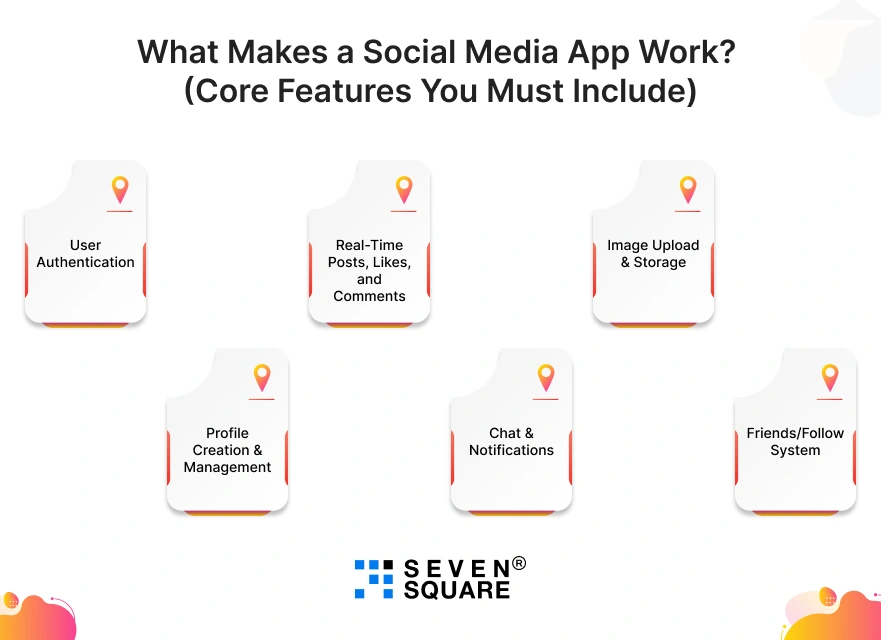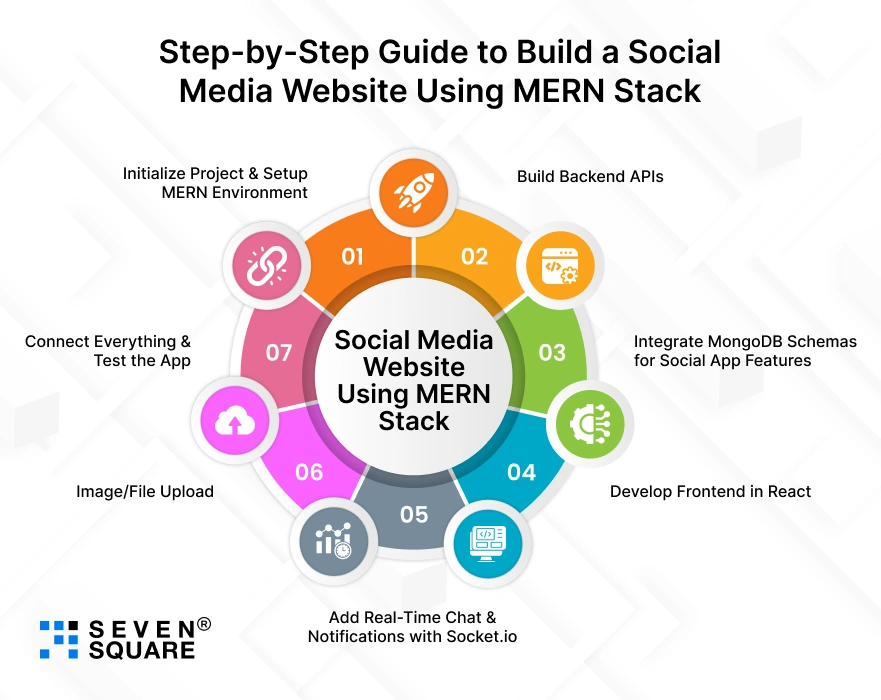Social media isn’t just about Facebook, Twitter, or Instagram anymore.
New niche social networks are launched every day; platforms for gamers, learners, fitness lovers, and even local communities.
That’s why developers and entrepreneurs often ask: “Can I build my own social media app using MERN stack?” The answer is yes.
The MERN stack (MongoDB, Express.js, React, Node.js) is one of the most popular frameworks for creating scalable, real-time applications.
It gives you everything you need to build a full social media website in MERN, from backend APIs and database design to frontend UI and real-time communication.
- MongoDB: Perfect for handling user profiles, posts, comments, and likes.
- Express.js & Node.js: Build secure, high-performance APIs.
- React: Create an engaging, responsive user experience for feeds and profiles.
If you are trying to build social media website using MERN, this blog is for you, as you will get GitHub code that you can fork and customize as you want.
What Makes a Social Media App Work? (Core Features You Must Include)

Let’s understand what makes a social media app in MERN stack tutorial valuable.
Whether you’re a developer building a prototype or a founder exploring an MVP, your platform needs the following core features:
- User Authentication (JWT + MongoDB): Secure login and signup system.
- Profile Creation & Management: Users can set up personal details, profile pictures, and bios.
- Real-Time Posts, Likes, and Comments: Keep the feed alive with instant updates.
- Chat & Notifications (Socket.io): Direct messaging and instant alerts boost engagement.
- Image Upload & Storage: Allow users to share pictures using Multer, Cloudinary, or AWS S3.
- Friends/Follow System: Let users connect and grow their network.
A social media website isn’t just about coding a feed; it’s about creating community, interactivity, and real-time experiences.
Learn How You Can Take Inspiration from Social Voice App Like Ten Ten.
What is MERN Stack Social Media Website Architecture? (Step-by-Step)
The MERN stack social media app architecture connects frontend, backend, and real-time systems into one smooth experience. Here’s how it works:
- Backend Setup (Node.js + Express): Build RESTful APIs for authentication, posts, likes, and comments.
- MongoDB Database Design: Create collections for users, posts, comments, and follow relationships.
- React Front-End Structure: Design pages like newsfeed, profile, chat, and explore.
- Connecting Backend APIs with Frontend: Use Axios/Fetch to link your APIs with React components.
- Real-Time Communication Layer (Socket.io/WebSockets): Add live chat, instant notifications, and activity tracking.
Step-by-Step Guide to Build a Social Media Website Using MERN Stack (With Code + GitHub)

If you’ve ever wondered “How to build a complete social media website in MERN stack?” This step-by-step guide is for you.
Whether you’re a developer learning full-stack skills or a business owner planning to launch a platform, follow these steps to get a working MERN social media app.
Step 1: Initialize Project & Setup MERN Environment
Create a new project folder and initialize it:
mkdir mern-social-app
cd mern-social-app
npm init -y
Install server dependencies:
npm install express mongoose cors dotenv bcryptjs jsonwebtoken
npm install --save-dev nodemon
Initialize frontend (React):
npx create-react-app client
Setup folder structure:
mern-social-app/
┣ client/ # React frontend
┣ server/ # Express backend
┣ .env
┗ package.json
Step 2: Build Backend APIs (User Auth, Posts, Comments)
Create server/index.js for Express backend:
const express = require("express");
const mongoose = require("mongoose");
const dotenv = require("dotenv");
const cors = require("cors");
dotenv.config();
const app = express();
app.use(express.json());
app.use(cors());
mongoose.connect(process.env.MONGO_URI, { useNewUrlParser: true, useUnifiedTopology: true })
.then(() => console.log("MongoDB connected"))
.catch(err => console.log(err));
app.get("/", (req, res) => res.send("MERN Social Media API Running"));
app.listen(5000, () => console.log("Server running on port 5000"));
For user authentication (JWT + bcrypt):
const jwt = require("jsonwebtoken");
const bcrypt = require("bcryptjs");
const User = require("./models/User");
app.post("/register", async (req, res) => {
const { username, email, password } = req.body;
const hashedPass = await bcrypt.hash(password, 10);
const user = new User({ username, email, password: hashedPass });
await user.save();
res.json({ message: "User registered!" });
});
app.post("/login", async (req, res) => {
const { email, password } = req.body;
const user = await User.findOne({ email });
if (!user) return res.status(400).json({ message: "User not found" });
const isMatch = await bcrypt.compare(password, user.password);
if (!isMatch) return res.status(400).json({ message: "Invalid credentials" });
const token = jwt.sign({ id: user._id }, process.env.JWT_SECRET);
res.json({ token, user });
});
Step 3: Integrate MongoDB Schemas for Social App Features
Create server/models/User.js:
const mongoose = require("mongoose");
const UserSchema = new mongoose.Schema({
username: String,
email: { type: String, unique: true },
password: String,
profilePic: { type: String, default: "" },
followers: [{ type: mongoose.Schema.Types.ObjectId, ref: "User" }],
following: [{ type: mongoose.Schema.Types.ObjectId, ref: "User" }]
}, { timestamps: true });
module.exports = mongoose.model("User", UserSchema);
Create server/models/Post.js:
const mongoose = require("mongoose");
const PostSchema = new mongoose.Schema({
user: { type: mongoose.Schema.Types.ObjectId, ref: "User" },
text: String,
image: String,
likes: [{ type: mongoose.Schema.Types.ObjectId, ref: "User" }],
comments: [{
user: { type: mongoose.Schema.Types.ObjectId, ref: "User" },
text: String
}]
}, { timestamps: true });
module.exports = mongoose.model("Post", PostSchema);
Step 4: Develop Frontend in React (News Feed, Profiles, UI)
Go to client/src/ and create a simple login form:
import React, { useState } from "react";
import axios from "axios";
function Login() {
const [email, setEmail] = useState("");
const [password, setPassword] = useState("");
const handleLogin = async () => {
const res = await axios.post("http://localhost:5000/login", { email, password });
localStorage.setItem("token", res.data.token);
alert("Login Successful!");
};
return (
<div>
<h2>Login</h2>
<input type="email" onChange={(e) => setEmail(e.target.value)} placeholder="Email" />
<input type="password" onChange={(e) => setPassword(e.target.value)} placeholder="Password" />
<button onClick={handleLogin}>Login</button>
</div>
);
}
export default Login;
Step 5: Add Real-Time Chat & Notifications with Socket.io
Install Socket.io:
npm install socket.io
Add to backend server/index.js:
const http = require("http").createServer(app);
const io = require("socket.io")(http, {
cors: { origin: "*" }
});
io.on("connection", (socket) => {
console.log("User connected: " + socket.id);
socket.on("sendMessage", (msg) => {
io.emit("receiveMessage", msg);
});
});
http.listen(5000, () => console.log("Server running on 5000 with Socket.io"));
Step 6: Image/File Upload (Multer + Cloudinary/AWS S3)
Install Multer:
npm install multer
Example upload route:
const multer = require("multer");
const storage = multer.diskStorage({});
const upload = multer({ storage });
app.post("/upload", upload.single("image"), (req, res) => {
res.json({ file: req.file });
});
For production, integrate with Cloudinary/AWS S3 for scalable image storage.
Step 7: Connect Everything & Test the App
Run backend:
cd server
nodemon index.js
Run frontend:
cd client
npm start
Test login, posts, likes, and real-time chat.
Here’s the Complete GitHub Code to Build Social Media Website in MERN stack.
What Are the Common Mistakes Developers Make? (And How to Avoid Them?)
Most MERN social media tutorials skip this, but here are real mistakes developers make:
- Not Optimizing MongoDB Queries: Leads to slow feeds & heavy load.
- Storing Images Directly in DB: Increases DB size and slows performance.
- Weak Authentication: Using plain passwords instead of hashing with bcrypt/JWT.
- Poor State Management in React: Causes bugs in feed updates & chat.
- Ignoring Deployment Optimization: Forgetting caching, CDN, or load balancing.
Avoid these mistakes, and your social media website in MERN stack will perform like a pro-level app.
What Are the Real-Time Features That Make It “Social”?
A static platform won’t keep users hooked. To make a truly real-time social media app in MERN, you need features that spark engagement:
- Live Chat & Messaging: Allow users to send instant messages.
- Instant Notifications: Notify users when someone likes, comments, or follows.
- Typing Indicators & Seen/Unseen Messages: Make conversations feel alive.
- Activity Status (Online/Offline): Show who’s active in real time.
These small yet powerful features make the difference between a simple clone and a next-gen MERN social media website.
Your Vision, Our Code: Social Media Apps in MERN Stack by Us
We specialize in developing custom social media websites using MERN Stack that help you bring ideas to life.
- MERN Stack Expertise: From MongoDB schema design to React-powered UIs, we’ve built end-to-end social media apps.
- Feature-Rich Development: Real-time chat, push notifications, image uploads, and social networking features all in one place.
- Secure Authentication: We implement JWT authentication, OAuth, and role-based access control to protect user data.
- Agile Delivery: Get your MERN social media website faster with swift delivery cycles.
- Business-Friendly Approach: We don’t just build apps, we build digital communities that engage users and drive revenue.
Want a Scalable Social Media App? Contact Us Now!
How to Make Your Social Media App Live?
Once your app is ready, it’s time to deploy the MERN social media app so the world can access it. Here’s how:
- Hosting Options: Use platforms like Heroku, Vercel, AWS, or Render for backend & frontend hosting.
- Environment Variables & Config: Securely store API keys, JWT secrets, and DB URLs.
- Database Scaling (MongoDB Atlas): Use sharding and clusters to handle large data volumes.
- Handling Millions of Requests: Node.js + MongoDB make MERN highly scalable, perfect for growing social platforms.
With the right setup, your MERN social media website can handle thousands & even millions of users.
Is MERN Stack the Future of Social Media Development?
The demand for social media apps in MERN stack is only growing.
Whether you’re a developer building a side project or a business launching a new platform, MERN gives you scalability, speed, and real-time power.
We tried to explain the architecture, core features, real-time additions, deployment, and common mistakes to avoid.
Now you can start building one according to your requirements.
FAQs
- Yes. MERN gives you all the tools, database (MongoDB), backend (Node + Express), and frontend (React), to create a full social media app.
- Use Socket.io or WebSockets to build real-time chat with seen/unseen status and typing indicators.
- Yes. With MongoDB Atlas scaling and Node.js event-driven architecture, a MERN social media app can handle large traffic loads.
- Deploy backend on AWS EC2/Elastic Beanstalk and frontend on Vercel. Use MongoDB Atlas for the database.